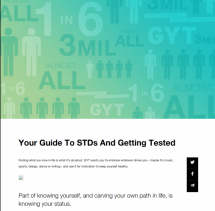Get Yourself Tested Campaign Materials
The GYT: Get Yourself Tested campaign is a youthful, empowering social movement to encourage young people to get tested and treated, as needed, for STDs and HIV. The campaign is a partnership between the American College Health Association, Kaiser Family Foundation, National Coalition of STD Directors, MTV, and Planned Parenthood Federation of America. Technical consultation for GYT is provided by the U.S. Centers for Disease Control and Prevention.
GYT increases awareness about STDs and how to prevent them, links young people to STD testing services, and promotes a more open dialogue with partners and health care providers. After all, sexually active young people account for half of the 20 million new STDs occurring in the U.S. each year – and most don’t know they are infected.
Although GYT is a national campaign, schools, community organizations, health care providers, and health departments across the country have adapted GYT to fit their local demographic and host testing and awareness events.
GYT also has a website to help service providers which offers resources to help health care providers better serve younger patients. This site provides insight into what youth want to know about sexual health and STD testing, as well as resources for talking to patients about sexual history and STD testing, and GYT materials for clinics.
Source: US Centers for Disease Control and Prevention
Date of Publication: March 25, 2019
SIMILIAR RESOURCES
Tools
Examples
- Men's Reproductive Health Curriculum
- Family Planning Discussion Topics for Voluntary Counseling and Testing
- Program H: Working with Young Men
- African Transformation Toolkit
- VMMC Counseling Training Package
- Voluntary Medical Male Circumcision Infographic
- Toolkit for Transition of Care and Other Services for Adolescents Living with HIV
- Quick Guide to Vasectomy Counseling
- Comprehensive Condom Programming A guide for resource mobilization and country programming
- Voluntary Medical Male Circumcision In-Service Communication Best Practices Guide

